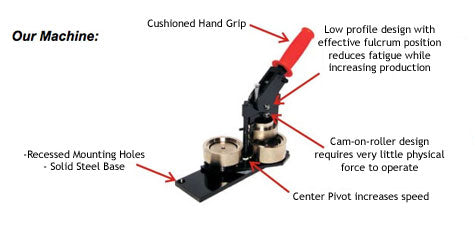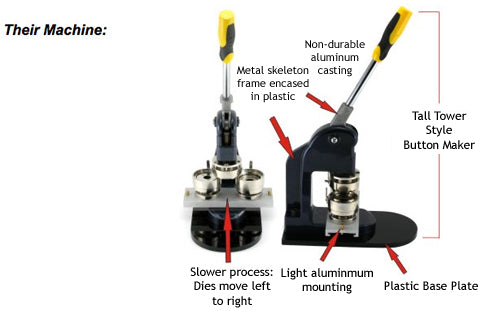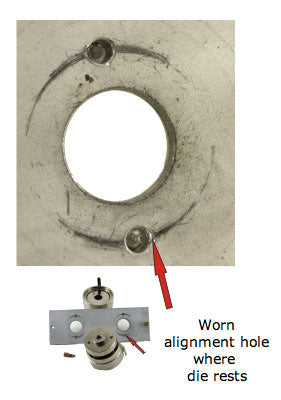Button Maker Usability Comparison: American v Chinese Button Makers
Over the last two days here at The Button Blog, we have discussed some of the differences between button makers made in America and those made in China. If you want to get caught up before this post, here are the links to the other two posts:
Today, we are going to take the next step and discuss the specific usability and design factors that make Chinese 3-in-1 button machines far less effective than single-size American-made button makers which, we reiterate, can be purchased in all-in-one button maker kits that are less expensive than the single multi-purpose Chinese-made machine. So, where do we start with the usability comparison? Simply put, there is no comparison. Our American button maker kits that are made in the USA are manufactured with higher quality parts and are both easier and more efficient to use than the Chinese competition. Nothing more perfectly illustrates the differences than the two videos we are about to show you below. First, here is a video that illustrates the complexity of using a Chinese 3-in-1 button machine. (By the way, if you are at work or do not speak Chinese, you should probably turn down the volume on your computer.) Notice about 2 min 40 seconds into the video how long it takes to set the photo and plastic mylar in the die properly. Then notice how much force is needed to press the button together. The back of the button machine raises off of the table! Not a very friendly design. Now take a look at this video, which shows how efficient our button makers are to use: Now let's break down some of the usability and design differences between our button maker and a Chinese-made product. Below the images you will find a detailed descriptions of the differences. 
 With our button machines, the button supplies are loaded directly in front of the operator so they do not have to make time consuming moves to the left and the right to load parts while also moving the dies back and forth (as shown in the Chinese video above), which slows down production. Our design incorporates two dies that swivel on a center axis providing speed and accuracy at such levels that our button machines are able to produce a button in as little as five seconds. To make a button you load the button supplies into the two lower dies. The “dies” are the three chrome-plated items you see on the button machine. To make a button, each lower die is independently moved under the upper die so when the handle is pulled the button parts are all pressed together. The design of our button maker kits incorporates two hardened steel nickel plated dies that swivel on a center axis. The Chinese machine has two dies that must be moved from the left to the right to load the button supplies. Then the dies must be moved back to the left again during the button making process to remove the complete button and load new parts again. Now look at how the two dies are attached. Our dies are mounted on a base of industrial grade steel. China’s dies, on the other hands, are simply sitting on what looks and feels like very light aluminum. So China has two heavy dies and lets gravity naturally hold them in place in a piece of soft metal?
With our button machines, the button supplies are loaded directly in front of the operator so they do not have to make time consuming moves to the left and the right to load parts while also moving the dies back and forth (as shown in the Chinese video above), which slows down production. Our design incorporates two dies that swivel on a center axis providing speed and accuracy at such levels that our button machines are able to produce a button in as little as five seconds. To make a button you load the button supplies into the two lower dies. The “dies” are the three chrome-plated items you see on the button machine. To make a button, each lower die is independently moved under the upper die so when the handle is pulled the button parts are all pressed together. The design of our button maker kits incorporates two hardened steel nickel plated dies that swivel on a center axis. The Chinese machine has two dies that must be moved from the left to the right to load the button supplies. Then the dies must be moved back to the left again during the button making process to remove the complete button and load new parts again. Now look at how the two dies are attached. Our dies are mounted on a base of industrial grade steel. China’s dies, on the other hands, are simply sitting on what looks and feels like very light aluminum. So China has two heavy dies and lets gravity naturally hold them in place in a piece of soft metal?  See the close up in the picture to the left for further illustration. There is a very small hole where the die must sit to be aligned correctly in the vertical position with the upper die. The dies are already wearing the aluminum plate down and making the round hole an oblong hole. These holes are all that keep the dies aligned and China has chosen to mount them in soft metal, which we simply cannot endorse as anything close to a best practice for button machine manufacturing. How long do you think that will last? Their plate has two screws threaded into each end of the plate. This is what actually stops the dies when you are moving them from left to right. The problem with this design is the screws do not provide a precision stopping point below the upper die. You simply keep sliding the dies in one direction until the screw stops the forward momentum. Since the plate is not greased, you have to push harder to move the dies from left to right, eventually stopping when they come in contact with the screw protruding through the plate. The problem with this it that eventually the abuse that the screws have to withstand will wear out the threads in the aluminum and the machine is broken. Our two lower dies are securely fastened to the rotating plate so they do not move. This makes certain that our dies are aligned properly with the upper die each and every time, thus enhancing the overall usability of our button maker kits. Stay tuned, because tomorrow we are going to go through the differences in manufacturing quality that make our button maker kits superior to all-in-one Chinese button machines. Follow this link if you are still looking for a cheap button maker, and read our thoughts. In the meantime, visit the storefront over at our main website to browse our selection of beginner and professional button maker kits, which, as you now know, are far more easy to use than their Chinese competition!
See the close up in the picture to the left for further illustration. There is a very small hole where the die must sit to be aligned correctly in the vertical position with the upper die. The dies are already wearing the aluminum plate down and making the round hole an oblong hole. These holes are all that keep the dies aligned and China has chosen to mount them in soft metal, which we simply cannot endorse as anything close to a best practice for button machine manufacturing. How long do you think that will last? Their plate has two screws threaded into each end of the plate. This is what actually stops the dies when you are moving them from left to right. The problem with this design is the screws do not provide a precision stopping point below the upper die. You simply keep sliding the dies in one direction until the screw stops the forward momentum. Since the plate is not greased, you have to push harder to move the dies from left to right, eventually stopping when they come in contact with the screw protruding through the plate. The problem with this it that eventually the abuse that the screws have to withstand will wear out the threads in the aluminum and the machine is broken. Our two lower dies are securely fastened to the rotating plate so they do not move. This makes certain that our dies are aligned properly with the upper die each and every time, thus enhancing the overall usability of our button maker kits. Stay tuned, because tomorrow we are going to go through the differences in manufacturing quality that make our button maker kits superior to all-in-one Chinese button machines. Follow this link if you are still looking for a cheap button maker, and read our thoughts. In the meantime, visit the storefront over at our main website to browse our selection of beginner and professional button maker kits, which, as you now know, are far more easy to use than their Chinese competition!

 With our button machines, the button supplies are loaded directly in front of the operator so they do not have to make time consuming moves to the left and the right to load parts while also moving the dies back and forth (as shown in the Chinese video above), which slows down production. Our design incorporates two dies that swivel on a center axis providing speed and accuracy at such levels that our button machines are able to produce a button in as little as five seconds. To make a button you load the button supplies into the two lower dies. The “dies” are the three chrome-plated items you see on the button machine. To make a button, each lower die is independently moved under the upper die so when the handle is pulled the button parts are all pressed together. The design of our button maker kits incorporates two hardened steel nickel plated dies that swivel on a center axis. The Chinese machine has two dies that must be moved from the left to the right to load the button supplies. Then the dies must be moved back to the left again during the button making process to remove the complete button and load new parts again. Now look at how the two dies are attached. Our dies are mounted on a base of industrial grade steel. China’s dies, on the other hands, are simply sitting on what looks and feels like very light aluminum. So China has two heavy dies and lets gravity naturally hold them in place in a piece of soft metal?
With our button machines, the button supplies are loaded directly in front of the operator so they do not have to make time consuming moves to the left and the right to load parts while also moving the dies back and forth (as shown in the Chinese video above), which slows down production. Our design incorporates two dies that swivel on a center axis providing speed and accuracy at such levels that our button machines are able to produce a button in as little as five seconds. To make a button you load the button supplies into the two lower dies. The “dies” are the three chrome-plated items you see on the button machine. To make a button, each lower die is independently moved under the upper die so when the handle is pulled the button parts are all pressed together. The design of our button maker kits incorporates two hardened steel nickel plated dies that swivel on a center axis. The Chinese machine has two dies that must be moved from the left to the right to load the button supplies. Then the dies must be moved back to the left again during the button making process to remove the complete button and load new parts again. Now look at how the two dies are attached. Our dies are mounted on a base of industrial grade steel. China’s dies, on the other hands, are simply sitting on what looks and feels like very light aluminum. So China has two heavy dies and lets gravity naturally hold them in place in a piece of soft metal?  See the close up in the picture to the left for further illustration. There is a very small hole where the die must sit to be aligned correctly in the vertical position with the upper die. The dies are already wearing the aluminum plate down and making the round hole an oblong hole. These holes are all that keep the dies aligned and China has chosen to mount them in soft metal, which we simply cannot endorse as anything close to a best practice for button machine manufacturing. How long do you think that will last? Their plate has two screws threaded into each end of the plate. This is what actually stops the dies when you are moving them from left to right. The problem with this design is the screws do not provide a precision stopping point below the upper die. You simply keep sliding the dies in one direction until the screw stops the forward momentum. Since the plate is not greased, you have to push harder to move the dies from left to right, eventually stopping when they come in contact with the screw protruding through the plate. The problem with this it that eventually the abuse that the screws have to withstand will wear out the threads in the aluminum and the machine is broken. Our two lower dies are securely fastened to the rotating plate so they do not move. This makes certain that our dies are aligned properly with the upper die each and every time, thus enhancing the overall usability of our button maker kits. Stay tuned, because tomorrow we are going to go through the differences in manufacturing quality that make our button maker kits superior to all-in-one Chinese button machines. Follow this link if you are still looking for a cheap button maker, and read our thoughts. In the meantime, visit the storefront over at our main website to browse our selection of beginner and professional button maker kits, which, as you now know, are far more easy to use than their Chinese competition!
See the close up in the picture to the left for further illustration. There is a very small hole where the die must sit to be aligned correctly in the vertical position with the upper die. The dies are already wearing the aluminum plate down and making the round hole an oblong hole. These holes are all that keep the dies aligned and China has chosen to mount them in soft metal, which we simply cannot endorse as anything close to a best practice for button machine manufacturing. How long do you think that will last? Their plate has two screws threaded into each end of the plate. This is what actually stops the dies when you are moving them from left to right. The problem with this design is the screws do not provide a precision stopping point below the upper die. You simply keep sliding the dies in one direction until the screw stops the forward momentum. Since the plate is not greased, you have to push harder to move the dies from left to right, eventually stopping when they come in contact with the screw protruding through the plate. The problem with this it that eventually the abuse that the screws have to withstand will wear out the threads in the aluminum and the machine is broken. Our two lower dies are securely fastened to the rotating plate so they do not move. This makes certain that our dies are aligned properly with the upper die each and every time, thus enhancing the overall usability of our button maker kits. Stay tuned, because tomorrow we are going to go through the differences in manufacturing quality that make our button maker kits superior to all-in-one Chinese button machines. Follow this link if you are still looking for a cheap button maker, and read our thoughts. In the meantime, visit the storefront over at our main website to browse our selection of beginner and professional button maker kits, which, as you now know, are far more easy to use than their Chinese competition!
Beginner and Professional Button Maker Kits from ABM
Brighid Brown - Director of Blogging and All Things Cool at ABMShare this post
0 comment
